- info@wildlife-removal.com
Call us for help in your town
Wildlife Removal Education
Raccoon Trapping Tips & Methods
Need raccoon removal in your hometown? We service over 500 USA locations! Click here to hire us in your town and check prices - updated for year 2020.
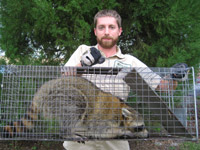
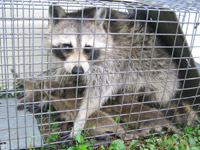
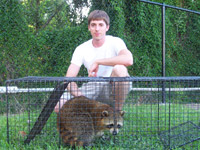
STEP 1: Purchase a large and sturdy steel cage large enough to hold raccoons. 12x12x36 is a
preferable size. There are many good makers of cage traps, from Havahart to Tomahawk, etc.
STEP 2: Set the trap on a flat and stable surface in the area you are having raccoon problems. Make sure the trap doesn't wobble. Be sure the trap is set correctly, with appropriate pan tension. Make sure the trap is not near anything that a raccoon can destroy, because they will reach out of the trap once caught and
tear up anything within reaching distance, like wires, screens, etc. They will also dig.
STEP 3: Bait the trap with non-meat bait. Meat will attract stray cats. White bread and marshmallows do well. Lead some of the bait up to the trap, and put some in the back of the trap, behind the trip pan.
STEP 4: Once caught, be very careful handling the trap. Do not stick your fingers inside the trap, or even hold it close to your body or you might get attacked by the raccoon. Place it in the trunk of your car or bed of your truck and relocate the animal at least ten miles to an approved area.
If you're not licensed to trap and remove or relocate animals in your state, which you are probably not, it's illegal for you to trap and remove raccoons yourself. There are many intangibles and risks that make do-it-yourself trapping problem-ridden. I've seen an amazing amount
of user error when it comes to trapping wildlife. Your best bet, although pricier, is usually to call a licensed professional. Below is an email that I recently received regarding a raccoon problem.
Other raccoon articles I've written:
raccoon in the chimney
raccoons in the attic
how to get rid of raccoons - house, yard, tree, roof
raccoons in the pool
how to trap raccoons
raccoon bait
raccoon poop
raccoon removal
raccoon pest control
raccoon damage
raccoon repellent
raccoon in the house
raccoon trapping laws
Raccoons live in a wide variety of habitats and the technique used in trapping any of them is determined by the location of its den. The raccoon will seldom build a den far from its food source, and this means that the target raccoon may live anywhere from a corn field, beside a running stream, to a house attic. This factor must be considered in choosing the type of trap and trapping technique to employ.
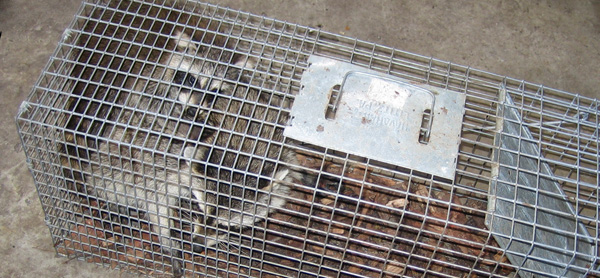
Types of Traps
Paw Hold traps: commonly used by fur trappers. It basically uses a small snapping device to clamp down on an animal’s paw and hold it; there are several different types of paw hold traps. Trappers that use this type of trap, usually kill off the captive raccoon by shooting thereafter. This trap type is not humane and is discouraged for wildlife trappers.
Body Grip Traps: this type is both difficult and dangerous to use; almost only used by old time fur trappers. The most common is the double spring-loaded connibear trap. They work by snapping down on the animal when sprung, and killing it via choking or squeezing. Lethal traps are inhumane and there are much better alternatives for wildlife trappers.
Live Cage trap: this is the trap of choice for wildlife control companies and hands-on homeowners. Live cage traps just as the name suggests, are large metal cages into which animals are lured by food. Once inside, the raccoon steps on a trip pan, which triggers the trap door to shut quickly. The most common brand of this trap is the Havahart brand. Non-professionals that want to trap raccoons with this trap must avail themselves of all necessary considerations when using raccoon traps.
- For optimum results, multiple traps should be set in different locations, but all in the path of the raccoon, that is close to its den.
- Due to the fact that raccoons are nocturnal animals, traps must be checked every morning, and advisably twice a day in order to spot and release non-target animals quickly.
- The bait should be changed every 2 days in order to get the desired results
- A heavy weight should be placed on traps to prevent mobility or the raccoon tipping it over. If set indoors, the trap may be nailed to the rafters or any nearby plank.
- The cage must be large enough for the raccoon to fit inside. Most raccoon-size cage traps are at least 32 inches long and 12 inches high and wide
- Be sure to check with your game and wildlife department for regulations before trapping any raccoon so you don’t get in trouble with the law.
Baits and Lures
Being an omnivorous feeder that will eat almost anything, the raccoon will be trapped using any of diverse baits and lures. It is however better to appeal to its sweet tooth and leave a trail of marshmallows, mini-donuts, or white bread that leads the raccoon into the trap. The larger share of the bait should be placed at the back of the trap behind the trip pan. The use of meat-based bait is discouraged because it is likely to attract the wrong animals - opossums, skunks, or cats.
When aiming to trap a raccoon in the water, it is best to use bait like carp, fish oil, fish juice, shellfish oil and salmon oil; although a sweet bait would also work.
It may not be necessary to make use of bait when trying to trap a raccoon that lives in a house attic.
NOTE: Watch out for baby raccoons! It is very important to note that 80% of raccoons that make their den in attics are female species with babies. They habitually seek a quiet and cozy place to have and keep their young. Thus, wildlife trappers must ascertain if the trapped raccoon is a mother by checking its nipples, and thereafter ensure that the babies are also removed from the attic. If this is not done, the babies may starve and die off in the attic, becoming an even greater problem.
Some wildlife trappers rescue the babies from the attic first, and then use them as bait to trap the mother raccoon. This always works as they are fiercely protective of their young, but must be carried out with great caution. It is advisable to call in experts when dealing with a raccoon family.
Tip number one:
The first trapping tip that is essential to any task is: Are you allowed to trap the animal? There are some animal, like raccoons, that pose a serious health risk to people.
If you’re inexperienced in trapping and don’t know a lot about raccoons, you might find yourself in a situation where you’re accidentally exposed to something sinister—like
rabies. Because of this risk, most states require you to have a wildlife license to remove a raccoon from your home. If you live in an area where legalities aren’t an issue,
the next thing you’ll need to figure out is what type of trap to use.
Tip number two:
Decide where you need to set out your trap. Most raccoons in an attic won’t enter a cage trap set inside the building. Your best bet is to secure the device
to the roof or rig it so the raccoon enters the trap once it’s left the interior of the home. One way door traps that lead into cages are popular, especially for raccoons
that live in a chimney. If you’re going to trap the animal, tip number three is: Figure out what bait is best. For raccoons, though they’ll eat just about anything, using
marshmallows or bread in your trap will decrease the chance of catching your neighbor’s cat.
Also read about:
What happens to a raccoon after a rehabilitator traps it?
Reader Email:
Hi,
I have read your website with great interest. We have raccoon problems,
namely raccoon triplets. We leave in suburban Philadelphia in a densely
populated residential area. We do not barbecue or leave food out. (but
our neighbors do.)
For about the past three weeks we have seen three, sometimes only two
raccoons. I usually hear them coming across our kitchen roof and then
they come down and go across a plant rail around our deck. I have taken
a number of photos of them, and they do not seem to be afraid of much of
anything. I think they are young, and I haven't seen a larger animal with them.
I actually don't think they are foraging for food. They seem like they are out
there to "have fun" We have sprayed them with a hose and they just climbed
high enough in the tree so the stream of the hose wouldn't reach with any force.
They actually looked like they might have enjoyed it. My husband has used
a BB gun when they were in the tree. I have gone out swinging a long bamboo pole to
try to get them off the deck area. That makes me uneasy, as there are three of them
and I am now afraid one will jump off the roof on to my back. When I open my
back door to go out, they are actually only 2 ft from my head!!! Last week they
were up crawling around there in broad daylight, about 5:30 in the afternoon!!
Most of the time I don't hear or see them until about 9:30PM. A few nights
ago in the rain one was sliding around on the skylight right above where I
sit at my computer.
We have just gone up to our attic and don't see any signs of them there, but
I am almost positive they are in the soffits.
Our township game warden has given out all of the traps and suggested that
I buy one, which I did, and he said he will "service it." It is a hav a heart trap.
We have baited it three times and been unsuccessful at trapping anything.
I know we are supposed to put it in their pathway, but I don't think we should
put it on the plant rail or on the roof.
The first night we put it on a paved walk in our back yard and the next morning
the bait was gone and the trap door shut and the trap was over into the flower
bed. The warden felt that the raccoon had been caught halfway and struggled
and struggled to get free and that's why the cage was in a different spot.
I am not sure where to turn next, as we have been unsuccessful at trapping them.
The local warden said he was a little concerned that there were three of them.
Do you have any suggestions about how I can proceed? We are only about 3 miles
from the city limits of Philadelphia and we have neighbors about 20' away on either
side. Recently I heard that there was a TV program about raccoon problems in
the city itself, but I didn't see it, as I don't watch TV. I will send photos in the
next email.
Thank you in advance for any advice you might give.
Best,
Diane
Diane - I'm very surprised that the game warden gave you traps. Nevertheless, raccoon trapping is often very tricky. Follow the above steps, but if you're having bad luck, you may have to call a pro. - David
Trapping a raccoon -
Trapping a raccoon is something that most states require be left to professionals with proper licensing. Raccoons carry a number of diseases, the most lethal of which is rabies.
Because of the high prevalence of this fatal virus within the species, most states do not allow non-licensed homeowners to trap raccoons. If you are allowed to take this task on,
you’ll need to purchase a cage trap, a one-way repeater or exclusion trap. or a special chimney trap — it depends on where the raccoon is located. Body grip or leg hold traps
are best left to fur trappers, because they are difficult and dangerous for novices to set. When trapping in a house or attic, remember that most of these animals inside of a
home are female. It is very rare, but not impossible, to find a lone male living in a building. If you can remove the babies without harassing the mother you should do so immediately.
You can even use the babies as a lure to get the mother into a cage trap. Other methods entail securing a cage trap to the hole in the building and scaring the mother raccoon out and
into the device. If you’re not keen on being too close to the animal, bolting the trap to the roof where the raccoon enters the building might prove successful. Remember to place traps
on a flat surface where no debris or alarming tilt can scare the animal away.
Tools for Raccoon Trapping
If you are planning on trapping a raccoon that is on your land, you will need a lot of stuff. Many home and property owners just aren't aware of quite how much work goes into the removal of wild animals, and especially ones like raccoons. They are large, carry some weight, have claws and teeth, alongside dextrous little paws, and they're super intelligent too. These are not dumb animals; to treat them as such would be your mistake.
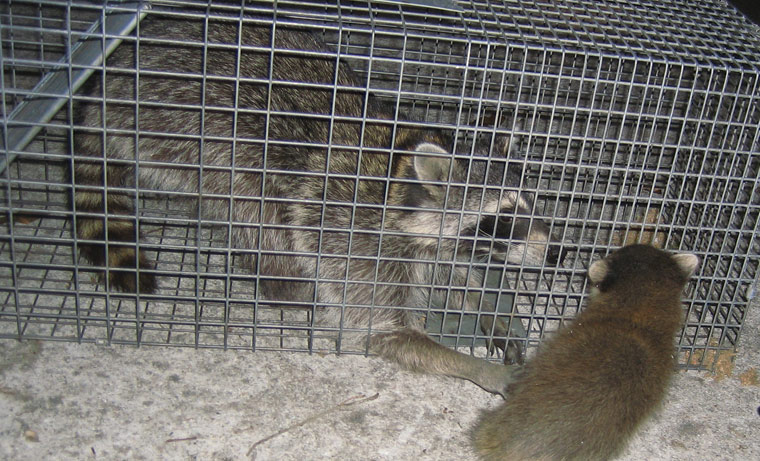
The kind of tools you will need for a raccoon trapping journey will depend very much on where the animal is, whether or not it has kits (baby raccoons), and what efforts you have already attempted.
If the animal is in a wall cavity, a snare pole might be necessary to get it out. If the raccoon isn't easily accessed from the attic using the snare pole, a piece of the wall may need to be cut out and then replaced, once the raccoon interloper has been safely removed. The latter is obviously going to need a lot more ‘stuff' than the former. Wall-cutting tools, plaster, wallpaper or paint ... all the stuff you'd need to repair a hole in the wall, and then some.
If the raccoon is casually chilling in your attic, you may find that an exclusion device works better than a trap, but only when you're dealing with adult raccoons. Young kits won't be brave enough to leave their nests for at least a few months, so the exclusion device will just seal the mother out and trap the kits in. The kits will probably die. Either that or the mother will rip apart actual bits of your home in a bid to get to them. She is not going to be happy about what you've done, that's for sure.
Exclusion devices are a bit like traps - they are long and cage-like, like a trap, but rather than sealing the animal inside the cage once the trigger has gone off, a door simply shuts. There isn't a cover to the opposite end of the trap, so the animal is free to leave and go off wherever it wishes.
With youngsters, you might need to get a bit more hands-on, although you will need to ensure you have adequate safety equipment for the whole business. Raccoon contact and removal requires gloves and eye protection, a face or breathing mask, a full suit and shoe protection (or shoes that you don't mind burning), alongside bait, perhaps more than one trap, disposal bags, a fire, and more cleaning stuff than you will ever have needed to use before in your life.
Raccoon removal is a dirty and quite dangerous job.
Disease-causing bacteria and viruses are present in raccoon poop, urine, other biological matter, bedding/nesting material, chewed materials, and even materials that have come into contact with the raccoon. Raccoon roundworm can be found in the form of eggs in raccoon skat - feces. When the feces has turned dry and dusty, it is believed that the roundworm eggs then have the potential (although, this is argued) to be sent airborne and can be inhaled. The most common form of infection is when someone handles raccoon-contaminated material and then put their hands in their mouth.
Although DIY raccoon removal might sound like the cheapest way to solve the problem, it is often not. By the time you have bought traps, cleaning equipment, safety gear, and everything else that you might (or might not) need in order to get job done safely and effectively, you might as well have just called in the professionals to begin with. In our experience, many property owners resort to rehabilitators when their efforts have proved useless anyway.
How to Trap a Trap-Shy Raccoon
A trap-shy raccoon is one that has probably already been trapped once and was either released back into the wild again, ready to live another day and learn from some pretty harsh and scary lessons, or it has learned through other raccoons that traps are a very bad thing. It isn't just raccoons that can be trap-shy either - all intelligent animals can. Rats are very similar and are also known to swipe food without setting the trap off or just avoiding them altogether.
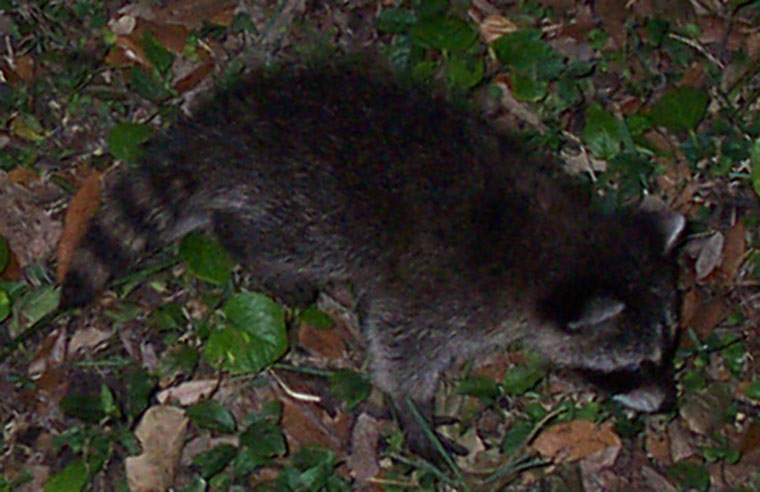
The first thing that you should do with a trap-shy raccoon is stop putting the trap down. You might have a trap-shy raccoon on your hands, but there's a good chance that your trap is just in the wrong place. Sometimes, even the most experienced raccoon trapper in the world will need to move the things around a couple of times before they have any success.
The next thing that you should do is allow the raccoon to become comfortable with the trap. The way that you do this is by putting the trap down, without food in it, and without setting it. Just like the trap isn't meant for the raccoon at all. Leave it there for one or two nights, before doing the same thing WITH bait. The idea is that you will give the animal time to familiarize itself with the new silver object in its living space. Once it realizes that the trap isn't going to go off and capture the poor thing, it will be much happier about going on, no seconds thoughts, and that's when you are going to have much more success.
Of course, as well as placement and slowly setting the raccoon trap, letting the animal get comfortable, you could also look at what kind of bait you're adding to the trap. In almost all cases, bait really isn't the important thing and it will rarely be bait that prevents the animal from being trapped.
Go back to the Raccoon Removal page, or learn tips to do it yourself with my How to Get Rid of Raccoons guide.


















